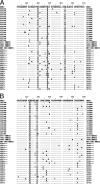Variations in reverse transcriptase and RNase H domain mutations in human immunodeficiency virus type 1 clinical isolates are associated with divergent phenotypic resistance to zidovudine
- PMID: 17724152
- PMCID: PMC2151428
- DOI: 10.1128/AAC.00646-07
Variations in reverse transcriptase and RNase H domain mutations in human immunodeficiency virus type 1 clinical isolates are associated with divergent phenotypic resistance to zidovudine
Abstract
Mutations in the RNase H domain of human immunodeficiency virus type 1 RT have been reported to cause resistance to zidovudine (ZDV) in vitro. However, very limited data on the in vivo relevance of these mutations in patients exist to date. This study was designed to determine the relationship between mutations in the RNase H domain and viral susceptibility to nucleoside analogues. Viruses harboring complex thymidine analogue mutation (TAM) and nucleoside analogue mutation (NAM) profiles were evaluated for their phenotypic susceptibilities to ZDV, tenofovir (TNF), and the nonapproved nucleoside reverse transcriptase inhibitors (NRTIs) beta-2',3'-didehydro-2',3'-dideoxy-5-fluorocytidine (Reverset), beta-D-5-fluorodioxolane-cytosine, and apricitabine. As controls, viruses from NRTI-naïve patients were also studied. The pol RT region (codons 21 to 250) of the viruses were sequenced and evaluated for mutations in the RNase H domain (codons 441 to 560) and the connection domain (codons 289 to 400). The results showed that viruses from patients failing multiple NRTI-containing regimens had distinct TAM and NAM profiles that conferred various degrees of resistance to ZDV (0.9- to >300-fold). Sequencing of the RNase H domain identified five positions (positions 460,468, 483, 512, and 519) at which extensive amino acid polymorphisms common in both wild-type viruses and viruses from treated patients were identified. No mutations were observed at positions 539 and 549, which have previously been associated with ZDV resistance. Mutations in the RNase H domain did not appear to correlate with the levels of phenotypic resistance to ZDV. Although some mutations were also observed in the connection domain, the simultaneous presence of the L74V and M184V mutations was the most significant determinant of phenotypic resistance to ZDV in patients infected with viruses with TAMs.
Figures


References
-
- Bethell, R. C., Y. S. Lie, and N. T. Parkin. 2005. In vitro activity of SPD754, a new deoxycytidine nucleoside reverse transcriptase inhibitor (NRTI), against 215 HIV-1 isolates resistant to other NRTIs. Antivir. Chem. Chemother. 16:295-302. - PubMed
-
- Brehm, J., D. Koontz, V. Pathak, N. Sluis-Cremer, and J. Mellors. 2006. Abstr. 13th Conf. Retrovir. Opportunistic Infect., abstr. 601.
-
- Calvez, V., D. Costagliola, D. Descamps, A. Yvon, G. Collin, A. Cecile, C. Delaugerre, F. Damond, A. G. Marcelin, S. Matheron, A. Simon, M. A. Valantin, C. Katlama, and F. Brun-Vezinet. 2002. Impact of stavudine phenotype and thymidine analogues mutations on viral response to stavudine plus lamivudine in ALTIS 2 ANRS trial. Antivir. Ther. 7:211-218. - PubMed
Publication types
MeSH terms
Substances
Associated data
- Actions
- Actions
LinkOut - more resources
Full Text Sources
Molecular Biology Databases
Research Materials

